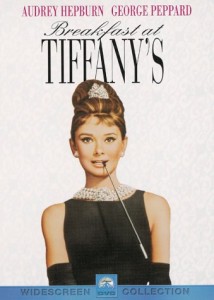 “Breakfast at Tiffany’s.â€
“Breakfast at Tiffany’s.â€
It sounds so idyllic, pastoral, and…delicious. Some may think that it is all about a small town called Somewhereville, USA, where a Southern belle named Tiffany (quite an all-American name) is serving, under the relaxing sounds of country music, bacon and eggs to the local churchgoers on a Sunday morning, right after mass. It is almost so, except for some minor details. The somewhere is called Manhattan, the Southern belle is a powder room girl named Holly Gollighty, the breakfast actually consists of a Danish and a cup of coffee grabbed on the run, and the diner is Tiffany and Co.’s window on Fifth Avenue.
Author Truman Capote has a knack of putting a red herring in the title of his most celebrated novella and director Blake Edwards exposes in full, thanks to an emblematic cast, this cunning title in his 1961 romantic comedy “Breakfast at Tiffany’s.†Even though the book and the film differ in terms of the final resolution, the iconic characters, places, and situations are just brought to life straight from the page.
As a matter of fact, the opening scene tells it all. Texan nubile Lula Mae, aka Holly (Audrey Hepburn, “Sabrinaâ€) steps out of a taxi holding her meager breakfast and stares in disbelief at the lustrous jewelry on display at Tiffany’s- one of the most expensive and prominent jewelry stores in the world.
With her mixture of naïve looks, bombastic dressing style and surreal behavior, Hepburn makes believe that Capote’s novella is not a piece of pure fiction, but rather a historical account. Hepburn’s trade mark-ish bun and cigarette holder have turned the very title of the film into a common name in the American households. Being voted one of the most chic actresses in Hollywood, the Britton should perfectly have won the Oscar for Best Actress for which she was nominated. George Peppard, on the other hand, has a rather bleak and inert appearance in the film.
The 1961 BAFTA nominee does only as much as serving as a foil character to Holly’s frivolity and hidden vulnerability.
Mickey Rooney and Alan Reed, on the other hand, represent the comic relief of the plot and, at the same time, show how seemingly carefree characters such as Holly can be easily taken advantage of. Rooney, who is originally Scottish, is very believable in his portrayal of a Japanese man and his often uncoordinated behavior illustrates the Eastern uneasiness on the background of the American versatile philosophy on life. Despite the relatively small time on screen, Reed’s character leaves the impression of the fatherly yet self-interested figure that the former Lula Mae needs and, at the same time, should be aware of.
The whole setting of the movie- the posh Manhattan streets, the wild high-class parties, the smoke filled cabaret scenes- are nothing short of emblematic for the typical atmosphere of the early sixties. The song “Moon River†with which Holly serenades the entire brownhouse and sparkles love interest and writer’s bug in Varjack gives even more romanticism to the lavish scenes. It is no wonder, therefore, that “Moon River†got the Academy Award for Best Soundtrack.
“Breakfast at Tiffany’s†is definitely a must-see film…and a reminder that we all should have our Tiffany’s to retreat to every once in a while.

Leave a Reply